Inspirations and Influences
From time to time I've been asked how I came up with Hive Time. While there are many of parts of the game that I think primarily came from my own or Mim's imagination, no substantial work is ever created in a vacuum. Hive Time draws upon and is a part of the legacy of a number of other games. Some of these influences are easy to see, with Hive Time sitting more or less within the "management sim" genre, but others may be a little less direct or more obscure.
I generally avoid taking about a project's inspirations and influences until after that project has established its own identity. Since what stands out or sparks the imagination is enormously subjective and will vary strongly from player to player, it's a little bit too easy to set false expectations. As an example, Swooper was the primary inspiration behind Honeycomb CRUNCH, but they're entirely different games and may not even appeal to the same audiences.
Now that Hive Time's been out for a couple of months, I wanted to take some time to dive in and celebrate the games that I drew inspiration from. Last week, I streamed some rambling discussion of and gameplay from five games that informed, inspired, and/or influenced the game that Hive Time would eventually become.
Below are summaries of SimCity, Dune II, Flotilla, Spacebase DF-9, and MASSIVE CHALICE along with the aspects of each that I drew upon during Hive Time's development.
Enjoy!
SimCity (1989)
Developed by Will Wright and team (Maxis)
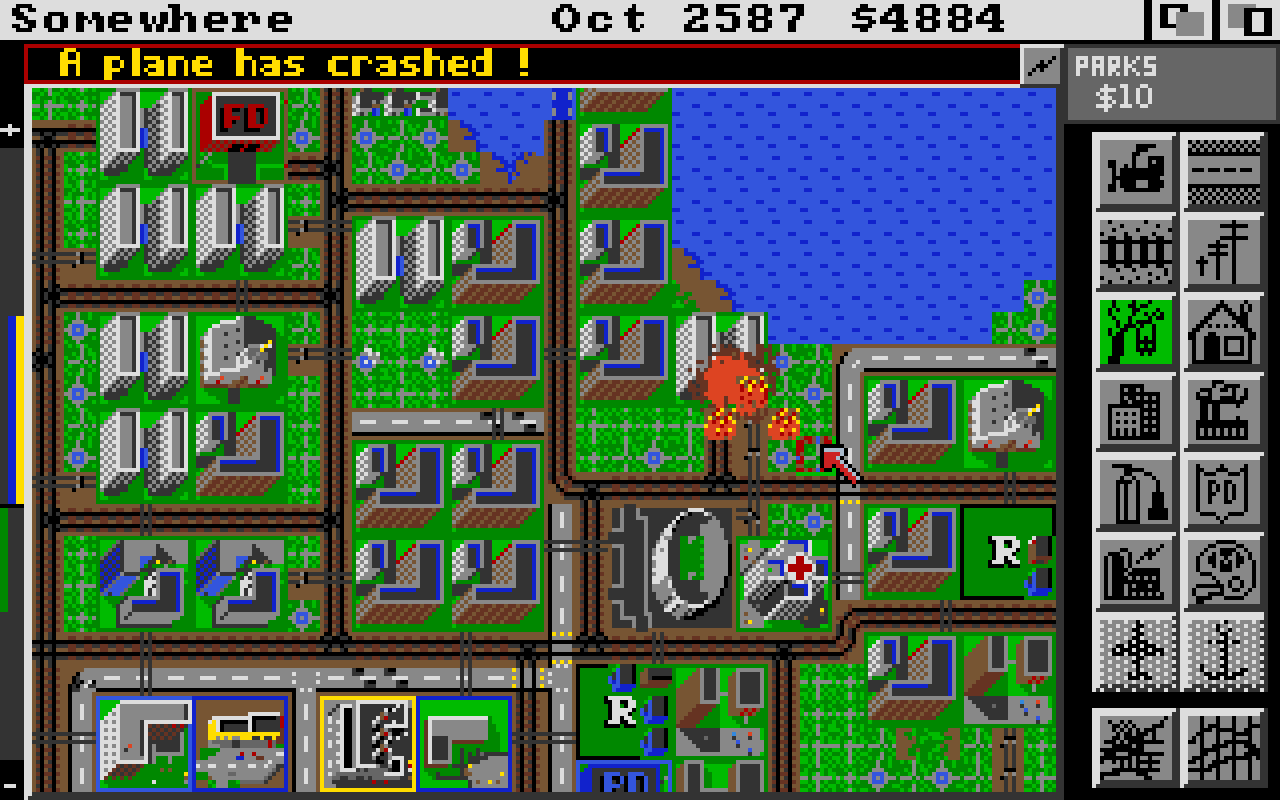
My family got its first computer in 1987. Our Amiga 500 was where I first learned to type, where I first experimented with programming, digital art, animation, and so forth. The games that I had access to were often wildly different, and that diversity helped shape the way that I appreciate digital experiences. We had a couple of versions of SimCity, but the first one I played was the original 512 release (requiring 512kB of memory). A later release would have improved graphics and the ability to play with different tilesets, in which I mostly made moonbases, but also enjoyed the futuristic European tileset.
The game was originally created for the C64 by Will Wright in 1985 as Micropolis, growing out of a level/environment editor he had created while working on top-down helicopter shooter Raid on Bungeling Bay. Over the following half a decade, the company Maxis would be founded, and additional contributors would be brought on board to work on the game's eventual release version, which shipped on ten platforms between 1989 and 1992.
SimCity wasn't the first management sim, but it did a lot to widely popularise the genre and solidify city builders as a subgenre. As another management sim, Hive Time obviously carries forward many of SimCity's sensibilities. How the specifics work isn't quite the same, but constructing facilities and spaces in order to achieve goals and fulfil needs is definitely something that I drew upon for Hive Time.
One of the things I appreciated most about SimCity while playing were that it presented a simulation with unclear but learnable dynamics, rewarding experimentation and observation while learning, while still presenting an interesting and rewarding experience after that learning phase was over. SimCity was likely the first game I really got into that was effectively endless without an ever-increasing difficulty curve, where a player continues managing their city so long as they're having fun. For some players, the most enjoyable part is growing a new city, while for others, it's in keeping an established city ticking. I wanted Hive Time to be approachable in a similar way, though instead of requiring players to start an entirely new game, Hive Time allows some continuity for players who'd rather play a string of new hives than look after one massive one.
SimCity's graphics are pretty minimal by more modern sensibilities, but I find them to have a level of detail and intricacy that implies and supports the notion that there's a little world that extends beyond what you can see. When Mim and I first started to consider what Hive Time's various cell types might look like, details that suggested more of what's going on (like blocks in the Nursery or hammers and saws in the Workshop) were something we wanted to make sure we included.
- Game without an end
- Intricate detail implies unseen activity
- Rewards/requires experimentation and observation when influencing the simulation
Dune II (1992)
Developed by Aaron E. Powell, Lyle J. Hall, and team (Westwood)
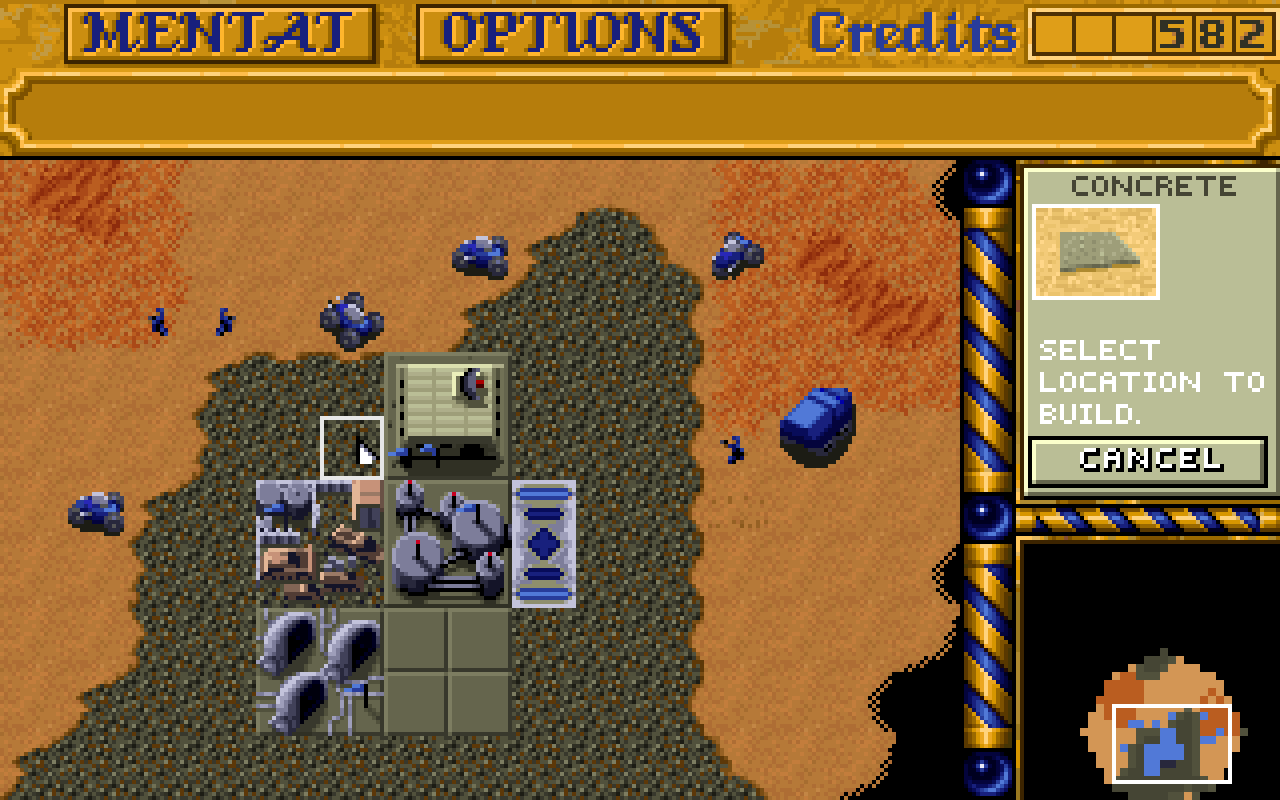
I think the first time I came across Dune II it was on a friend's Amiga. I'd already seen and enjoyed the world presented in the films, and while the game seems to draw more from the books (which I hadn't read at the time), it gave me something to be excited about and pulled me into the game. Years later, I'd pick up the DOS version and play it more thoroughly, but my early experiences were what shaped the game's identity in my mind.
Like SimCity, Dune II (also known as Dune II: The Building of a Dynasty or Dune II: The Battle for Arrakis depending on region) was not the first, but very much a foundational RTS responsible for further establishing the genre and pioneering conventions that would be seen in three decades of strategy games since. It was Westwood's first RTS, and paved the way for the even more prominent Command & Conquer franchise.
Genres are tricky - I typically don't like to use them since they invite one to assess a work based on the merits of other works rather than its own, but sometimes they're useful for expectation management. With that in mind, I don't consider Hive Time to be a strategy/RTS game per se, and it's definitely not something I've steered clear of when talking about it. There's a lot that I like about RTS games in general and about Dune II specifically, but there isn't much that I drew upon for Hive Time.
The one thing that always stood out to me from the beginning was the requirement to place concrete slabs in order to make portions of the game world buildable. These in turn would have to be placed on rock, making construction space a limited resource in the sand-rich world of Arrakis. There's a bunch of stuff about terraforming and dominating natural environments to unpack from both this game and its source material that I won't go into here (consequences for mistaking Arrakis' deserts as barren and lifeless, mistaking its people as being meek and ineffectual, and so forth are themes that tend to surface in the books), but I did appreciate the way that it divides construction into allocating space and then building functional structures. The resource and time costs involved would allow room for planned space to need to be repurposed before the originally intended structure was ready, and that in itself made construction more interesting. Although I'm on the fence about whether or not Hive Time's balance of cost/construction duration manages to pulls off something similar, the idea of requiring empty cells to be constructed before functional cells could be built on them came from Dune II's concrete slabs.
- Two-step construction process encourages pre-planning, provides additional resource constraints, and gives rooms for construction plans to be interrupted by shifting priorities
Flotilla (2010)
Developed by Brendon Chung (Blendo Games)
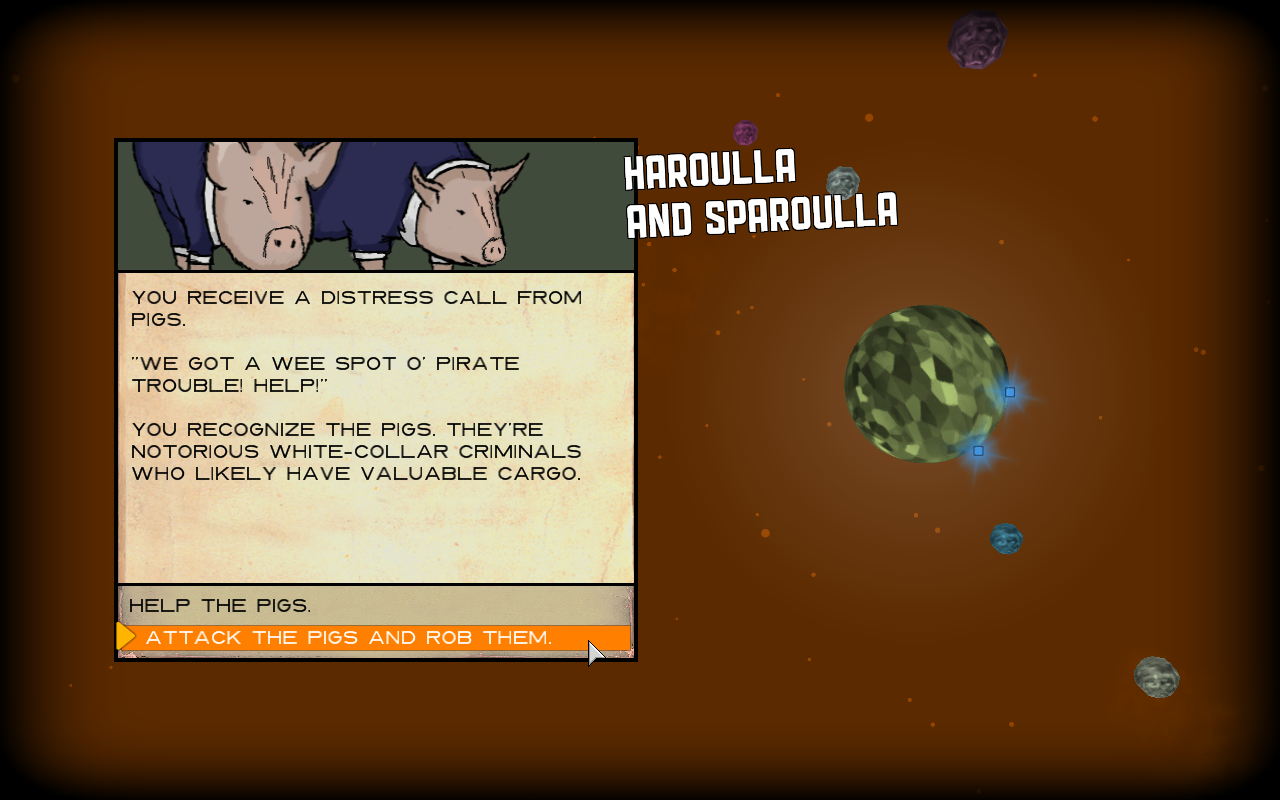
While Flotilla was initially released in 2010, it didn't receive a Linux port until April 2019, the week before Mim and I started work on the initial Hive Time prototype. I've played and enjoyed a number of Brendon's previous games, and while Flotilla is dramatically different from Gravity Bone, Atom Zombie Smasher, or Quadrilateral Cowboy, it's at also immediately recognisable as a Blendo game.
I mentioned in last week's stream that without commenting on the amount of work that goes into his games, Brendon's works always have a sense of effortless elegance to them. They typically have a tight, well polished core focus, accentuated and amplified by supporting aspects that add context and imply a larger world. In a broad sense, this was something I aimed for in Hive Time as well - the core gameplay of balancing population dynamics and managing the hive should be capable of standing on its own, while all other aspects should expand the world and provide some other optional distractions without getting in the way of that core gameplay.
At its core, Flotilla is a turn based tactics game, where capital ships face off against each other with turns occurring simultaneously, requiring players to anticipate enemy manoeuvres and deal with the consequences when something unexpected occurs. This comes wrapped in a short story generator, where between combat encounters, players must respond to events that typically offer binary choices.
Events feature a cast of zany and unexpected characters that add a richness and vibrancy in what would otherwise feel sterile and clinical universe. The admiralty of a xenophobic space deer empire might aggress you for unknowingly salvaging a derelict in their space, bandit space cats might demand your help in hiding from authorities, or cable-chewing baby space yetis might present an ethical dilemma. This style of event presentation that presents tangential problems that expose facets of a larger world is something that I think can easily be seen reflected in Hive Time's events.
At the end of each Flotilla adventure (all of which have a hard limit on how long they can be, framed as the player character entering the final phase of a terminal illness at the outset), a log shows all of the events and choices that were encountered along the way, presenting that as a single narrative for the player to reflect on. Initially, I had planned something similar for Hive Time, which would have allowed event histories to be viewed at any point during gameplay, but as the game grew into a longer, more sprawling experience where individual events might end up being repeated, it made progressively less sense and the idea was eventually retired.
- Narrow scoped and focused core game that is expanded by side-content that provides context
- Implies a bigger more interesting world through events/vignettes
Spacebase DF-9 (2014)
Developed by JP LeBreton and team (Double Fine)
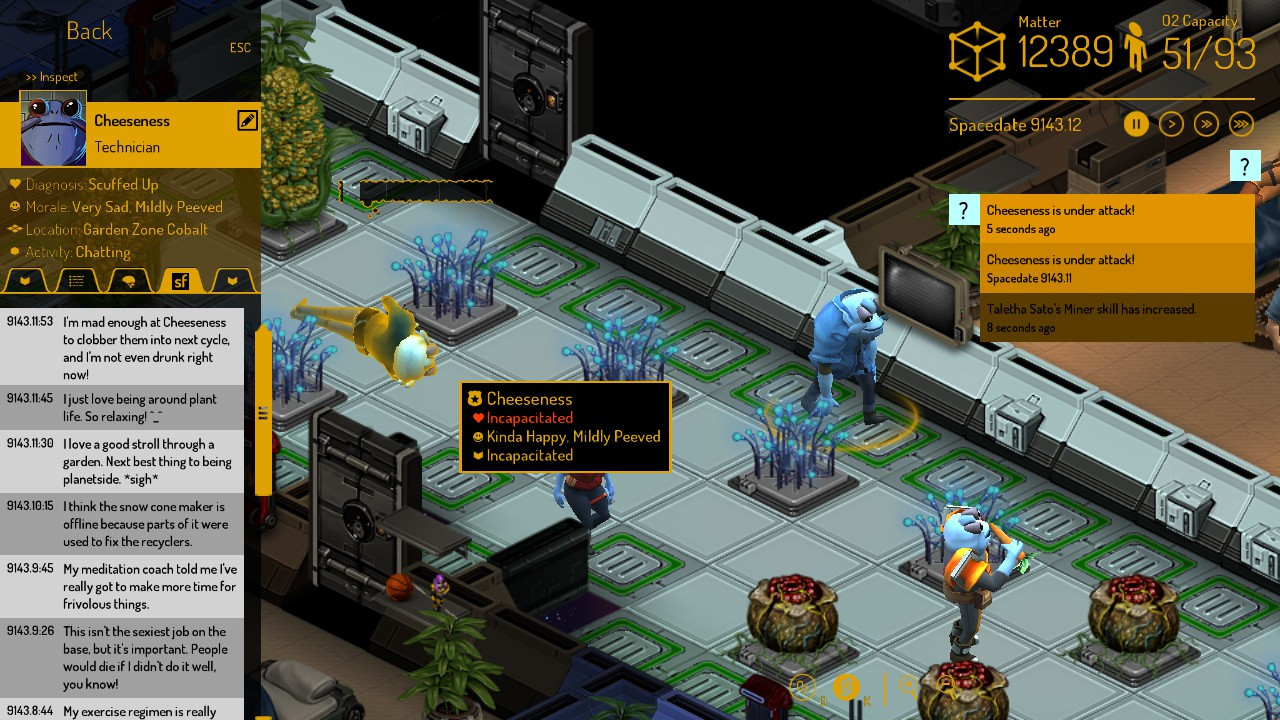
Since I was a little busy focused on other things during the Amnesia Fortnight that the initial Spacebase DF-9 prototype was created for, I didn't end up playing the game until the first Early Access builds were ready to go live. At the same time, I was solidifying my working relationship with Double Fine, stepping up to help fill more community facing roles in addition to running the Double Fine Game Club. Immediately, throughout development, and even after, it was a game that I found a lot of enjoyment in. With my name slipped into the game early on, I enjoyed seeing/hearing of a Cheeseness that had joined players' bases. For a time, I was collecting screenshots of dead Cheesenesses in the hopes of eventually making a big photomosaic out of them, but with the eventual negativity that would come to surround that project, that became difficult to continue with.
Spacebase DF-9 is difficult to talk about. The situation surrounding its release was nuanced, messy, and not so relevant here beyond acknowledging that the people whose lives, livelihood, and wellbeing were on the line were treated poorly and without empathy, and that no matter how disappointed one might be at a game not fulfilling one's hopes and dreams (or at expectation management that allowed those to spiral out of control), nothing justifies the harassment or threats that I witnessed.
Open development with a buy-in is difficult, and both developers and players are still coming to terms with navigating the new type of relationship it invites. Having a window into Spacebase DF-9's development helped me appreciate some of the kind of challenges I would eventually face with Hive Time. Beyond that, I also gained a better understanding of and framework for assessing the value of various genre conventions, allowing me to embrace and avoid various features with more confidence than I could otherwise have had, and ultimately contributing significantly to Hive Time's relatively short development cycle.
Spacebase DF-9 invites players to grow and maintain a base capable of sustaining its citizens and defending against raider attacks. Individual citizens' occupations can be set, but they can not be controlled directly (beyond setting waypoints for security officers), instead making players rely on and interact via the simulation to fulfil goals.
As in SimCity, the simulation itself isn't immediately readable, and observing citizen activities ends up being an important part of gameplay. The presentation of individual bees as entities that do the hive's work, but cannot directly be controlled aimed to evoke a similar feel. Their visible actions and activities allow a number of population states to be identified, though readability turned out to not be scalable when dealing with populations in the hundreds and I ended up adding some graphs and charts to make these things easier to read.
At a more detailed level, citizens' "SpaceFace" logs give further cues for morale and health, as well as some extra context for various base statuses and events. These are presented as short social media posts that end up providing a lot of characterisation and implying broader lives beyond the small snippets shown. Hive Time doesn't have any kind of simulation for individual bee health or social dynamics, but its vignettes grew out of a desire to provide similar small windows into bees' lives that would allow players to infer/project personally.
- Open development provided awareness of genre-specific concerns
- Allows characters' lives/priorities to be inferred by observing in-world behaviour
- Implies characters' ongoing lives and personality by presenting personal moments
MASSIVE CHALICE (2015)
Developed by Brad Muir and team (Double Fine)
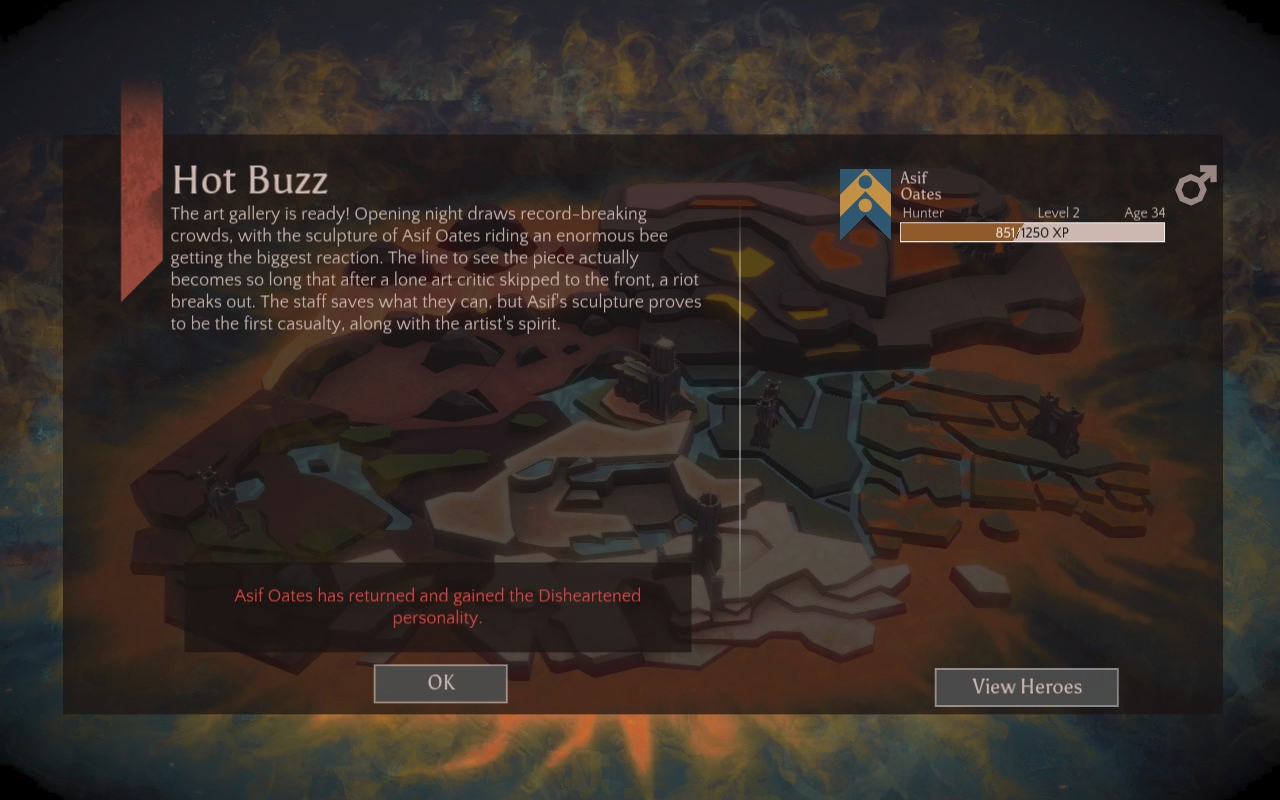
I don't recall precisely when I first played MASSIVE CHALICE, but it was during its Early Access period. I remember being impressed with the way that Brad and co were able to stick to what I had initially felt was an aggressive time schedule (the game shipped around six months later than was projected during the crowdfunding campaign that occurred before pre-production began) without putting significant stress on the team or significantly compromising the game itself. It, along with Spacebase, remains one of my favourite Double Fine games. Its gameplay, character, and aesthetic are contentious and bold, and its finale includes one of the few examples out there of mechanical storytelling - the special and unique quality that is specific to our medium.
MASSIVE CHALICE is a turn based squad tactics game crossed with a generational genealogy sim in which players must defend the last remnants of a fantasy land from the encroaching Cadence, an endless and inexplicable force bent on corrupting and consuming the entirety of existence. Players direct around a dozen generations of individuals from heroic bloodlines through battles that take place every decade or so, pairing regents in keeps to raise the next generation and pass on their expeirence.
As time passes, random events will occur that typically provide outcomes that will upset or interrupt various things that the player may be focusing on. This might mean corruption increasing or decreasing in a particular region, shifting risk and protection priority, or it might mean some trait change to an important hero rendering them no longer appropriate for a planned regency. Typically outcomes aren't known in advance, so players are invited to engage with events' narratives at face value and deal with whatever consequences ensue. The impact of Hive Time's events are sometimes a little more explicit, but they definitely draw upon this notion of upsetting player priorities by providing unexpected pressures. My hope is that in a game that is about finding and maintaining balances, making those balances delicate and subject to dramatic shifts brings some valuable tension and gives players some work to do even after they've learned the core mechanics.
Lastly, MASSIVE CHALICE's writing tends to have a thread of humour running through it. With the game infrequently surfacing writing, it's not always immediately obvious, but there is a playful tone that I wanted to try to capture. Hive Time's use of puns, outlandish situations, and overtly comedic moments likely exceeds what can be found in MASSIVE CHALICE, but the origin of its humour is rooted within MASSIVE CHALICE.
- Events distract focus and disrupt plans
- Writing often carries a playful, comedic tone
And that's about it! This isn't an exhaustive list of games that might have influenced Hive Time, but it does cover everything that I consciously and specifically pursued or tried to capture. Other favourite management sims that I enjoy, such as Dungeon Keeper, Railroad Tycoon, Transport Tycoon, or Theme Park all likely contributed to my appreciation of and tastes in these types of games, but none of those have presence within Hive Time in a way that feels as direct and specific as the five covered here.
Thanks for reading!
Get Hive Time
Hive Time
A cute and zany bee themed management sim/base builder.
| Status | Released |
| Authors | Cheeseness, Mimness |
| Genre | Simulation |
| Tags | bee, City Builder, Cute, Hex Based, hive, Management |
| Languages | English |
| Accessibility | Configurable controls |
More posts
- Happy 5th beethday, Hive Time!Dec 12, 2024
- World Bee Day 2024 & v1.2-149, v1.2-150 changelogsMay 20, 2024
- Happy 4th beethday, Hive Time!Dec 12, 2023
- World Bee Day 2023 & v1.2-138, v1.2-139 changelogsMay 20, 2023
- Happy 3rd beethday and v1.2-129 changelogDec 12, 2022
- World Bee Day and v1.2-118, v1.2-119 changelogsMay 20, 2022
- v1.2-100 changelogJan 02, 2022
- Hive Time turns 2, and v1.2-95, v1.2-96 changelogDec 15, 2021
- v1.2-78 changelogSep 26, 2021
- v1.2-76 & v.12-77 changelogJun 05, 2021

Leave a comment
Log in with itch.io to leave a comment.